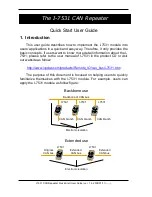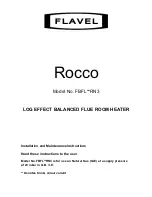
Section 2
DESCRIPTION
7
ing might be required depending on how the
fan is applied.
• Tube-axial type fans are the most common-
ly used type of booster fans.
• The selected fan should be non-overloading;
i.e. if the fan discharge or inlet is shut off, the
fan drive motor should not overload.
2.3 DESCRIPTION OF COMPONENTS
Sullair Integral Heat Recovery System are shown.
The complete package of a structural steel base
frame, inlet and discharge plenums, oil cooler
(aftercooler optional), motor and cooling fan, mois-
ture separator and heated trap, damper panels for
outdoor air, recovered heated air, bypass air, and
rejected heated air; two temperature probes; two
pneumatic cylinders; room thermostat; damper
actuator motor; solenoid valve; and a temperature
controller.
The following text explains the functional descrip-
tion of these components.
TEMPERATURE PROBE “A”- MIXED AIR
Probe A is mounted in the compressor enclosure,
where it monitors the temperature of the mixture of
bypass and outdoor air. Refer to Figures
The damper motor actuator will modulate so that
the set mixed air temperature will be maintained.
Since the mixed air temperature remains constant,
the heated exhaust air temperature will vary
depending on the demand for compressor loading.
The air temperature rise across the coolers can be
as little as 5ºF (3ºC) for a completely unloaded
compressor. This is a thermistor type of tempera-
ture probe.
TEMPERATURE PROBE “B”- OUTSIDE AIR
This probe monitors the outdoor air temperature.
When the outdoor temperature exceeds the set
value on the temperature controller, an electrical
signal is sent to the exhaust plenum damper motor
actuators, and the heated cooling air will be reject-
ed outdoors.
At the same time, the temperature controller sends
an electrical signal to the mixed air damper motor
actuator, which positions the dampers so that all
cooling air will enter the compressor cabinet from
outdoors.
ROOM THERMOSTAT
This thermostat monitors the temperature of the
heated space. If the set value on this thermostat is
exceeded, an electrical signal is sent to the exhaust
plenum damper motor actuators, and the heated
cooling air will be rejected outdoors.
DAMPER MOTOR ACTUATORS- RECOVERED
AND REJECTED AIR
The motor actuators control the movements of the
rejected and recovered air dampers. When the
compressor is not running, the motor actuators
maintain the recovered and rejected dampers in a
closed position.
When the compressor is running and the room ther-
mostat and the outside air temperature probe indi-
cate temperatures below their setpoints, the motor
actuator will fully open the recovered air damper
directing all heated cooling air to the heated space.
When the recovered air damper motor actuator
receives an electrical signal due to a rise in room
temperature, it will close the recovered air damper.
The rejected air damper actuator will simultaneous-
ly open the rejected air damper, directing all heated
cooling air outdoors.
MOTOR ACTUATOR- MIXED AIR
The motor actuator positions the outdoor and
bypass air dampers. It utilizes an electrical signal,
which is a function of the temperature sensed by
Probe “A”. The actuator maintains the outdoor air
damper in a closed position when the compressor is
not running.
Summary of Contents for EES LS25S Series
Page 18: ...Section 4 INSTALLATION 14 Table 2 Ductwork Static Pressure Loss Worksheet ...
Page 20: ...NOTES 16 ...
Page 26: ...NOTES 22 ...
Page 58: ...Section 6 ILLUSTRATIONS AND PARTS LIST 54 6 14 DECAL GROUP ...
Page 60: ...Section 6 ILLUSTRATIONS AND PARTS LIST 56 6 15 DECAL LOCATIONS ...
Page 63: ...Section 6 ILLUSTRATIONS AND PARTS LIST 59 6 17 WIRING DIAGRAM EES REMOTE 02250134 081R00 ...
Page 65: ...NOTES 61 ...












































